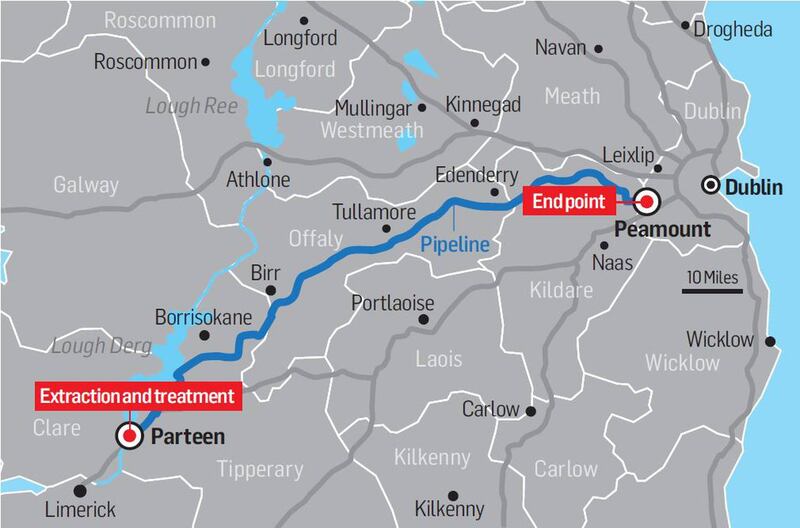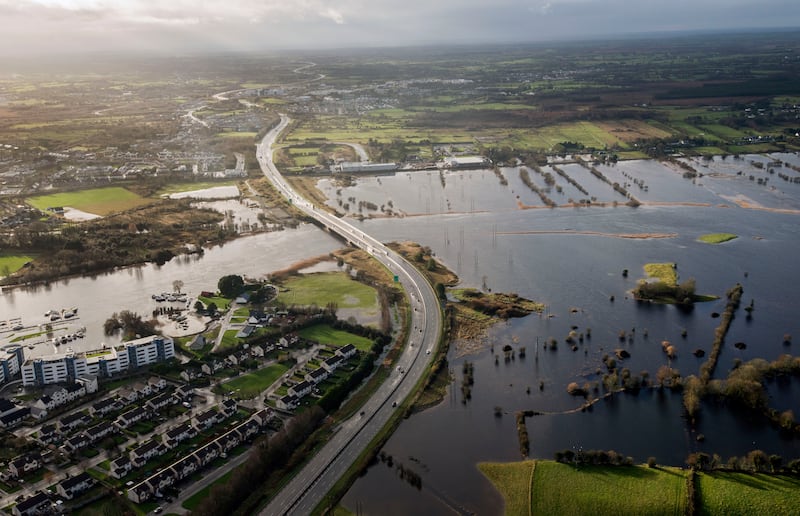Water supply issues are conspiring to threaten the Government’s housing targets in the Dublin area where 40 per cent of Ireland’s population is concentrated – and the problem could persist into the 2030s.
Uisce Éireann, the State-owned water utility company, has warned it may soon have to refuse to connect new homes in the Greater Dublin Area because supply is so overstretched, and it may have to stop supplying big non-domestic users.
In the past year alone, water demand in the region has increased by the equivalent of 120,000 homes to record levels. Some 628 million litres of water is used daily, some 13 million more than the system is designed to produce, the Water Forum, a statutory advisory body, has warned repeatedly.
A Housing Commission report due to be published next month is understood to set out dire consequences for new housing. It has been reported that the delivery of tens of thousands of homes is under threat amid a “high risk of major water shortages” in the area over the next six years.
Water supplies in Dublin are on a knife edge. A call by Uisce Éireann for conservation in the middle of winter sounded that alarm bell. Exacerbating factors linked to this come on top of constraints including planning delays in the construction sector already affecting the delivery of new houses. In this instance, an over-reliance on the river Liffey as a drinking water source and continuing high levels of leakage are compounding difficulties in the Dublin area, where there is fast-growing population and economic growth.
This is likely to get worse before it gets better, as most stakeholders agree that, even with effective leakage curtailment, the only lasting solution is to pipe water from the river Shannon to the eastern region, though this is many years away.

Conor O’Connell, director of Irish Home Builders’ Association, an industry representative and lobby group, says reality is dawning that new homes simply cannot be built without appropriate water supplies. It also highlights a fundamental point on critical infrastructure delivery, he adds, and this must be addressed urgently if housing is to be delivered to keep up with population growth.
Uisce Éireann has issued a serious warning to Government that many of their projects need to be activated, says O’Connell, backed by the appropriate consent process as delivery of these projects is taking too long.
The problem will become more acute as housing targets are likely be increased incrementally up to 60,000 new houses a year by 2030. This is in a scenario where lack of investment in infrastructure means that the State is “now playing catch-up”.
Housing targets will be revised once a structural housing demand report from the State’s economic think tank, the Economic and Social Research Institute, and verdict from the Housing Commission, which includes the input of property developers, are published and considered as part of the National Planning Framework.
Water supply problems are likely to materialise “in a few years”, predicts O’Connell. Right now, delays are due to other connection issues, such as wastewater treatment or power supply.
Ireland is bucking international trends as its population is getting bigger “so a lot more houses and a lot more water are needed”
— Dr Matt Crowe, chairman of the Water Forum
Cairn Homes built more houses and apartments than any other developer in Ireland last year. James Benson, director of strategic delivery and policy at the company, says that in delivering 1,748 units, mostly in the Dublin area, it had no capacity issues with utility companies Uisce Éireann and the ESB. Similarly with 2,200 units due this year, “that capacity is there”, he says.
It deploys a “sustainable delivery platform” to ensure efficient building timelines with planning and water supply secured. This also determines what has to be delivered in three years’ time. Cairn Homes moved in on site at its Seven Mills site in Clondalkin, west Dublin last year, where 1,300 homes will be built in the next few years “with capacity confirmation”.
However, the issue goes beyond that, he adds, and concerns how much capacity there is in the water supply system. “There might not be enough, particularly if there is an increase in housing targets and completions.”
Cairn has been alerted by Uisce Éireann “that there will be challenges ahead”. This underlines the need for upgrade works and critical infrastructure “to happen now” when planning and approval could be a four-year process, says Benson.
Dr Matt Crowe, chairman of the Water Forum, which advises Government on water policy and management, says Ireland is bucking international trends as its population is getting bigger “so a lot more houses and a lot more water are needed”. Climate projections for Ireland indicate less water availability, he says.
“The sweet spot in the middle is water conservation,” he says. “This is something we have been pushing hard ... We’ve been calling on the Government to introduce a national strategy for conservation.”

The business plan for the 170km Shannon pipeline has yet to be approved by Government, “so is not likely to be delivered for another 10 years”, he says. Water conservation and efficiencies can dampen demand and lesson pressure on the system in the meantime.
“Dublin has only a few days of water supply available at any one time. The Government plan to build 300,000 new homes in the next 10 years, which will further increase demand,” says Crowe.
The forum is concerned the Shannon option will not be in place to meet rising demand, “with additional risk from climate change predicted to increase drought and dry periods in this region”.
The strategy “should include a revision of building regulations to make new homes more water efficient”, similar to energy requirements, Crowe says. Mandatory standards for fixtures and fittings should be introduced in new developments.
Research shows such action can reduce water use by 20 per cent per person. A recent survey found 74 per cent of consumers supported conservation measures but did not know how much water they were using or how to conserve water.
“To avert water shortages in the Dublin region in coming years, change towards long-term water-efficient behaviours is essential,” he says.
“This will require a commitment from Government and water suppliers to proactively support water conservation action in homes and businesses. Communities need to be informed of the risks to supply so that they are encouraged to be more water efficient and value water more.”
Fixing the leaks is not enough. The current situation of a growing water supply deficit and lack of supply resilience is not sustainable
— Uisce Éireann
Subject to Cabinet approval to proceed to next stage, Uisce Éireann expects a planning application to be lodged for the Water Supply Project – Eastern and Midlands Region by early 2025 and, following completion of planning, construction to take four to five years. Projects of this scale, however, often encounter judicial review challenges.
The project timeline does not undermine the Government’s housing targets up to 2030, a spokesman says.
“Uisce Éireann is committed to supporting Housing for All and has plans in place to support housing in the short and medium term [with €6 billion investment]. Even with those plans, however, the supply for the [Greater Dublin Area] will remain constrained and vulnerable until a new water source is brought into supply.”
In 2023 the utility issued 4,597 connection offers associated with 42,970 housing units and only 144 refusals associated with 489 housing units nationally.
“The majority of refusals were associated with one-off single houses or small housing developments.”
It says leakage in the Dublin area, at 33 per cent (with a 20 per cent target for 2030), is lower than the national average.
“However, fixing the leaks is not enough. The current situation of a growing water supply deficit and lack of supply resilience is not sustainable.”
In 2023, Uisce Éireann has capacity to cater for 97 per cent of the targets set out in major urban areas and large towns, it notes. Uisce Éireann has developed plans for each water supply that makes up the public water supply in Ireland through its national water resources plan. “Within this plan we have identified that a significant percentage of the water supplies within the country are vulnerable,” it says.
For these water supplies, the utility is progressing interim projects, such as water treatment plant upgrades and leakage reduction, while it develops longer term options to resolve issues with these supplies.
“The Water Supply Project will enable growth, reliability and sustainability issues for 36 water supplies in the East and Midlands region, including supplies in Tipperary, Offaly, Westmeath, Meath and Wicklow,” the spokesman adds.
On FDI investment that could be at risk due to lack of water availability, it says: “Uisce Éireann engages with developers, non domestic customers and State agencies through [a] pre connection enquiry and connection application process which is commercially sensitive. We actively engage and work with the IDA to support FDI and investment in Ireland.”
The Department of Housing said following Government approval it expects to progress the Shannon plan to the next stage “in coming months”.
“While there is no immediate threat to housing or economic development, we note that many water sources in the region will be at capacity by the late 2020s,” a department spokesman said.
“The Government recognises this challenge and is working with Uisce Éireann to address it.”
Sign up for push alerts and have the best news, analysis and comment delivered directly to your phone
- Find The Irish Times on WhatsApp and stay up to date
- Our In The News podcast is now published daily – Find the latest episode here











